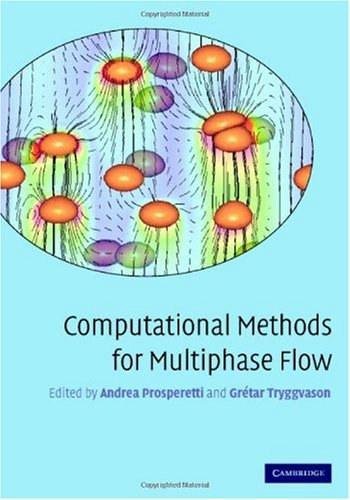(EBOOK PDF)Computational methods for multiphase flow 1st Edition by Andrea Prosperetti 9780511292149 0511292147 full chapters
$50.00 Original price was: $50.00.$35.00Current price is: $35.00.
Computational methods for multiphase flow 1st Edition by Andrea Prosperetti – Ebook PDF Instant Download/Delivery: 9780511292149, 0511292147
Full download Computational methods for multiphase flow 1st Edition after payment

Product details:
• ISBN 10: 0511292147
• ISBN 13:9780511292149
• Author:Andrea Prosperetti
Computational Methods for Multiphase Flow
Thanks to high-speed computers and advanced algorithms, the important field of modelling multiphase flows is an area of rapid growth. This one-stop account – now in paperback, with corrections from the first printing – is the ideal way to get to grips with this topic, which has significant applications in industry and nature. Each chapter is written by an acknowledged expert and includes extensive references to current research. All of the chapters are essentially independent and so the book can be used for a range of advanced courses and the self-study of specific topics. No other book covers so many topics related to multiphase flow, and it will therefore be warmly welcomed by researchers and graduate students of the subject across engineering, physics, and applied mathematics.
Computational methods for multiphase flow 1st Table of contents:
Acknowledgments
1 Introduction: A computational approach to multiphase flow
1.1 Some typical multiphase flows
1.2 A guided tour
1.3 Governing equations and boundary conditions
1.4 Some dimensionless groups
2 Direct numerical simulations of finite Reynolds number flows
2.1 Overview
2.2 Integrating the Navier–Stokes equations in time
2.3 Spatial discretization
2.4 Boundary conditions
3 Immersed boundary methods for fluid interfaces
3.1 The “one-fluid” approach
3.2 Advecting a marker function
3.3 The volume-of-fluid (VOF) method
3.4 Front tracking using marker points
3.5 The level-set method
3.6 Other methods to advect the marker function
3.7 Computational examples
3.7.1 Validation problems
3.7.2 Applications to physical problems
3.8 Conclusion
4 Structured grid methods for solid particles
4.1 Sharp-interface Cartesian grid method
4.1.1 Fluid?solid interface treatment
4.1.2 Other issues
4.2 Immersed boundary technique
4.2.1 Feedback forcing
4.2.2 Direct forcing
4.2.3 Discrete-time mass and momentum forcing
4.2.4 Using the exact near-body velocity
4.3 Body-fitted grids
4.3.1 Finite-volume technique
4.3.2 Spectral methods
4.3.2.1 Governing equations
4.3.2.2 Temporal discretization
4.3.2.3 Computational domain
4.3.2.4 Boundary conditions
4.3.2.5 Spectral discretization
4.3.2.6 Sample results
5 Finite element methods for particulate flows
5.1 Governing equations
5.2 Fully explicit scheme and its stability
5.3 Combined fluid?solid formulation
5.4 Arbitrary Lagrangian?Eulerian (ALE) mesh movement
5.5 Temporal discretization ? finite difference scheme
5.6 Spatial discretization ? Galerkin finite element scheme
5.7 Mesh generation
5.8 Projection scheme
5.9 Explicit?implicit solution procedure
5.10 Space-time finite element method
5.11 Distributed Lagrange multiplier/fictitious domain (DLM/FD) particle mover
5.12 Particle collision
5.13 Sample applications
6 Lattice Boltzmann models for multiphase flows
6.1 Brief history of the lattice Boltzmann method
6.2 Lattice Boltzmann equations
6.3 Lattice Boltzmann models for multiphase flow
6.3.1 Theory
6.3.1.1 Color-fluid model
6.3.1.2 Models based on interparticle potentials
6.3.1.3 Models based on free energy
6.3.1.4 Mean-field model
6.3.1.5 Phase function model
6.3.2 Applications of the lattice Boltzmann multiphase models
6.3.2.1 Multiphase flow in porous media
6.3.2.2 Rayleigh?Taylor instability
6.4 Fluid?wall interactions in the lattice Boltzmann simulations
6.4.1 The generalized lattice Boltzmann method with multiple relaxation times
6.4.2 The bounce-back boundary condition
6.4.3 Treatment of moving boundaries
6.5 Some test cases
6.5.1 Flow in porous media
6.5.2 An impulsively started cylinder moving in a 2D channel
6.6 Conclusion and discussion
7 Boundary integral methods for Stokes flows
7.1 Introduction
7.2 Preliminaries
7.2.1 Stokes flow limit
7.2.2 Stokes-flow problems in multiphase systems
7.2.3 Lorentz integral identities
7.2.4 Green’s functions
7.3 The boundary integral equations
7.3.1 Singularity subtraction
7.3.2 First-kind boundary integral formulation
7.3.3 Second-kind boundary integral formulation
7.3.4 A better form of the boundary integral equation
7.3.5 Rigid-particle limit
7.4 Multiparticle systems
7.4.1 System of viscous drops
7.4.2 Wielandt’s deflation
7.4.3 System of rigid particles
7.4.4 Periodic boundary conditions
7.5 Numerical integration methods
7.5.1 Surface discretization
7.5.2 Surface approximation methods
7.5.3 Evaluation of the single-layer and double-layer integrals
7.5.4 Iterative solution methods
7.5.5 Surface evolution
7.5.6 Acceleration methods
Appendix
8 Averaged equations for multiphase flow
8.1 Introduction
8.2 Volume averaging
8.2.1 Conservation of mass
8.2.2 Conservation of momentum
8.2.3 Conservation of energy
8.2.4 Simplified models
8.3 Disperse flow
8.4 Well-posedness of Eulerian?Eulerian models
8.4.1 A simple example
8.4.2 Quasilinear systems
8.5 Boundary conditions
9 Point-particle methods for disperse flows
9.1 Point-force approximation
9.2 Particle equation of motion
9.3 Numerical treatment of the particulate phase
9.3.1 Interpolation
9.3.2 Integration
9.4 Numerical treatment of the fluid phase
9.4.1 A second-order fractional-step methodfor incompressible flows
9.4.2 Boundary conditions
9.4.3 A Fourier series method for isotropic turbulence
9.5 Gas?solid flows
9.5.1 The undisturbed fluid velocity in point-particle treatments
9.5.2 Implementation of the coupling force
9.6 Examples
9.6.1 Particle-laden homogeneous and isotropic turbulence
9.6.2 Particle-laden slab flow
10 Segregated methods for two-fluid models
10.1 A general one-dimensional model
10.2 Discretization
10.2.1 Convection?diffusion equation
10.2.2 Calculation of cell-surface quantities
10.2.3 Equations of the two-fluid model
10.3 Calculation of the pressure
10.3.1 A simple incompressible model
10.3.2 Mass-conservation algorithms
10.3.3 The IPSA volume-conservation algorithm
10.3.4 Co-located variable arrangement
10.4 Example: fluidized beds
10.5 An Eulerian?Lagrangian scheme
10.5.1 Single-phase flow
10.5.2 Multiphase flow
10.5.3 Pressure calculation
10.5.4 Calculation of cell-surface quantities
10.6 A partially coupled algorithm
10.6.1 Mathematical model
10.6.2 Discretization
10.6.3 Boundary conditions
10.6.4 Method of solution
11 Coupled methods for multifiuid models
11.1 Mathematical models
11.2 First-order methods
11.2.1 A semi-implicit method
11.2.2 The SETS method
11.2.3 Implicit methods
11.2.4 Numerical diffusion and other difficulties
11.3 Introduction to high-resolution schemes
11.3.1 Scalar conservation laws
11.3.1.1 Discretization
11.3.1.2 Godunov’s method
11.3.2 Systems of equations
11.3.2.1 Roe’s approximate Riemann solver
11.3.2.2 Sources
11.3.2.3 Higher dimensionality
11.3.3 High-resolution schemes
11.3.3.1 Flux-limiter methods
11.3.3.2 Slope-limiter methods
11.4 Application to multiphase flow models
11.5 Flux vector splitting
11.6 Conclusions
References
Index
People also search for Computational methods for multiphase flow 1st:
computational methods for multiphase flow
computational methods for multiphase flows in porous media
computational methods for multiphase flow pdf
computational methods for multiphase flows in porous media pdf
computational techniques for multiphase flows
Tags:
Computational methods,multiphase flow,Andrea Prosperetti


